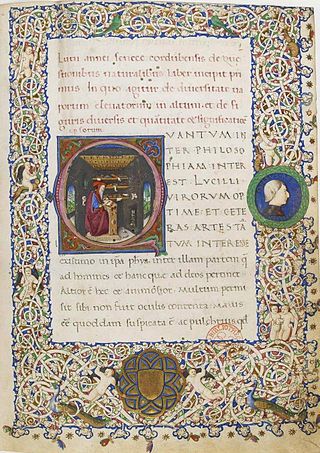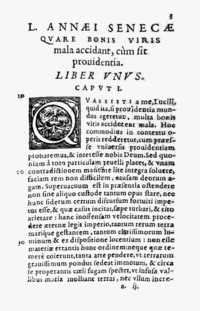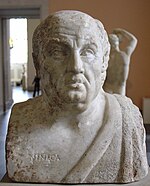
Lucius Annaeus Seneca the Younger, usually known mononymously as Seneca, was a Stoic philosopher of Ancient Rome, a statesman, dramatist, and in one work, satirist, from the post-Augustan age of Latin literature.

Aulus Persius Flaccus was a Roman poet and satirist of Etruscan origin. In his works, poems and satire, he shows a Stoic wisdom and a strong criticism for what he considered to be the stylistic abuses of his poetic contemporaries. His works, which became very popular in the Middle Ages, were published after his death by his friend and mentor, the Stoic philosopher Lucius Annaeus Cornutus.
Lucilius Junior, was the procurator of Sicily during the reign of Nero, a friend and correspondent of Seneca, and the possible author of Aetna, a poem that survives in a corrupt state.
Hecato or Hecaton of Rhodes was a Greek Stoic philosopher.

The Correspondence ofPaul and Seneca, also known as the Letters of Paul and Seneca or Epistle to Seneca the Younger, is a collection of letters claiming to be between Paul the Apostle and Seneca the Younger. There are 8 epistles from Seneca, and 6 replies from Paul. They were purportedly authored from 58–64 CE during the reign of Roman Emperor Nero, but appear to have actually been written in the middle of the fourth century. Until the Renaissance, the epistles were seen as genuine, but scholars began to critically examine them in the 15th century, and today they are held to be inauthentic forgeries.
Aristo of Chios, also spelled Ariston, was a Greek Stoic philosopher and colleague of Zeno of Citium. He outlined a system of Stoic philosophy that was, in many ways, closer to earlier Cynic philosophy. He rejected the logical and physical sides of philosophy endorsed by Zeno and emphasized ethics. Although agreeing with Zeno that Virtue was the supreme good, he rejected the idea that morally indifferent things such as health and wealth could be ranked according to whether they are naturally preferred. An important philosopher in his day, his views were eventually marginalized by Zeno's successors.

De Brevitate Vitae is a moral essay written by Seneca the Younger, a Roman Stoic philosopher, sometime around the year 49 AD, to his father-in-law Paulinus. The philosopher brings up many Stoic principles on the nature of time, namely that people waste much of it in meaningless pursuits. According to the essay, nature gives people enough time to do what is really important and the individual must allot it properly. In general, time is best used by living in the present moment in pursuit of the intentional, purposeful life.

Epistulae Morales ad Lucilium, also known as the Moral Epistles and Letters from a Stoic, is a letter collection of 124 letters that Seneca the Younger wrote at the end of his life, during his retirement, after he had worked for the Emperor Nero for more than ten years. They are addressed to Lucilius Junior, the then procurator of Sicily, who is known only through Seneca's writings.

De Vita Beata is a dialogue written by Seneca the Younger around the year 58 AD. It was intended for his older brother Gallio, to whom Seneca also dedicated his dialogue entitled De Ira. It is divided into 28 chapters that present the moral thoughts of Seneca at their most mature. Seneca explains that the pursuit of happiness is the pursuit of reason – reason meant not only using logic, but also understanding the processes of nature.
Quintus Lucilius Balbus was a Stoic philosopher and a pupil of Panaetius.

Stoicism is a school of Hellenistic philosophy that flourished in Ancient Greece and Ancient Rome. The Stoics believed that the practice of virtue is enough to achieve eudaimonia: a well-lived life. The Stoics identified the path to achieving it with a life spent practicing the four cardinal virtues in everyday life — prudence, fortitude, temperance, and justice — as well as living in accordance with nature. It was founded in the ancient Agora of Athens by Zeno of Citium around 300 BCE.
Seneca's Consolations refers to Seneca’s three consolatory works, De Consolatione ad Marciam, De Consolatione ad Polybium, De Consolatione ad Helviam, written around 40–45 AD.

Naturales quaestiones is a Latin work of natural philosophy written by Seneca around AD 65. It is not a systematic encyclopedia like the Naturalis Historia of Pliny the Elder, though with Pliny's work it represents one of the few Roman works dedicated to investigating the natural world. Seneca's investigation takes place mainly through the consideration of the views of other thinkers, both Greek and Roman, though it is not without original thought. One of the most unusual features of the work is Seneca's articulation of the natural philosophy with moralising episodes that seem to have little to do with the investigation. Much of the recent scholarship on the Naturales Quaestiones has been dedicated to explaining this feature of the work. It is often suggested that the purpose of this combination of ethics and philosophical 'physics' is to demonstrate the close connection between these two parts of philosophy, in line with the thought of Stoicism.

De Beneficiis is a first-century work by Seneca the Younger. It forms part of a series of moral essays composed by Seneca. De Beneficiis concerns the award and reception of gifts and favours within society, and examines the complex nature and role of gratitude within the context of Stoic ethics.

De Clementia is a two volume (incomplete) hortatory essay written in AD 55–56 by Seneca the Younger, a Roman Stoic philosopher, to the emperor Nero in the first five years of his reign.

De Tranquillitate Animi is a Latin work by the Stoic philosopher Seneca. The dialogue concerns the state of mind of Seneca's friend Annaeus Serenus, and how to cure Serenus of anxiety, worry and disgust with life.

De Ira is a Latin work by Seneca. The work defines and explains anger within the context of Stoic philosophy, and offers advice which utilizes virtue and personal improvement in order to prevent anger.

De Otio is a 1st-century Latin work by Seneca. It survives in a fragmentary state. The work concerns the rational use of spare time, whereby one can still actively aid humankind by engaging in wider questions about nature and the universe.

De Constantia Sapientis is a moral essay written by Seneca the Younger, a Roman Stoic philosopher, sometime around 55 AD. The work celebrates the imperturbability of the ideal Stoic sage, who with an inner firmness, is strengthened by injury and adversity.
Negative visualization or futurorum malorum præmeditatio is a method of meditative praxis or askēsis by visualization of the worst-case scenario(s). The method originated with the Cyreanic philosophers and was later adopted by Stoic philosophers. The technique was made popular with publications of Seneca the Younger's Epistulae Morales ad Lucilium. It is thought to have been one of the common forms of Stoic spiritual exercises.















